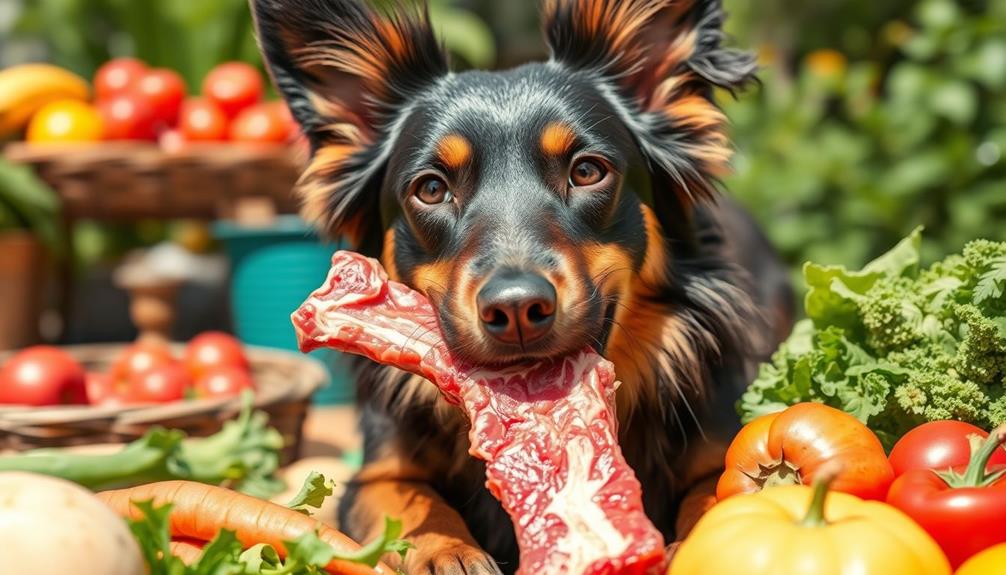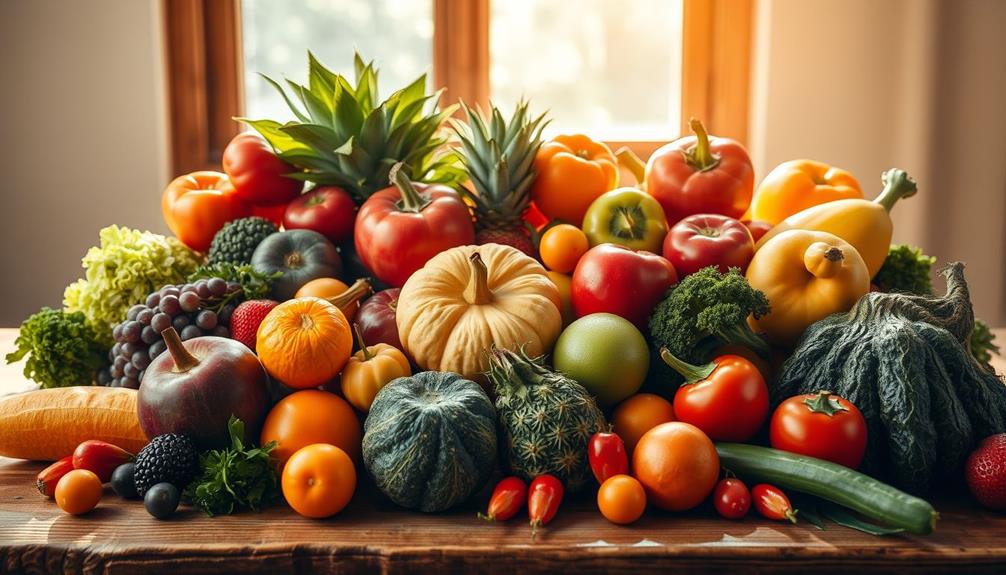Feeding your dog a raw food diet can bring various health benefits, including better digestion and shinier coats. Raw food consists of meat, bones, and sometimes veggies, providing high-quality proteins and essential nutrients. You'll likely notice improved dental health and reduced allergy symptoms. However, it's vital to adapt your dog slowly and consult a vet to avoid nutritional imbalances and health risks, like bacterial contamination. Remember, planning and hygiene matter. If you consider a raw diet, understanding your dog's specific needs is key for success, and there's much more to explore on how to implement it safely and effectively. When transitioning to a raw food diet for dogs, it’s essential to start with small portions to allow their digestive systems to adjust gradually. Additionally, it’s crucial to source high-quality ingredients and handle raw meat with care to prevent any foodborne illnesses for both your dog and yourself. By educating yourself on the proper handling and preparation of raw food, you can ensure that your dog receives all the benefits of a raw food diet while minimizing any potential risks.
Key Takeaways
- Raw food diets can enhance digestion and nutrient absorption by eliminating fillers found in commercial dog foods.
- Advocates report benefits such as shinier coats, healthier skin, and increased energy levels from bioavailable nutrients in raw diets.
- Properly balanced raw diets require careful planning to avoid nutritional deficiencies and ensure overall pet health.
- Hygiene practices during raw food handling are crucial to minimize bacterial contamination risks for both pets and humans.
- Transitioning to a raw diet should be gradual, with veterinary guidance to monitor health improvements and adjust portions accordingly.
Understanding Raw Dog Food
When you explore raw dog food, or the BARF diet, you'll discover it primarily consists of raw meat, bones, offal, and sometimes fruits and vegetables, mirroring what wild canines naturally consume. This diet originated from practices for racing greyhounds and sled dogs, gaining popularity after veterinarian Ian Billinghurst introduced it in 1993.
Raw dog food diets are often touted for their potential health benefits, including enhanced digestion and nutrient absorption, which can be vital for a dog's overall well-being.
There are two main types of raw dog food: homemade and commercially prepared diets. Homemade diets require careful planning to guarantee a balanced diet that meets your dog's nutritional needs, while commercially prepared options offer convenience with pre-formulated nutrition.
Advocates argue that raw dog food can lead to health benefits like shinier coats and improved dental health, thanks to its high-protein, unprocessed ingredients.
However, converting to a raw diet isn't without its challenges. You'll need to conduct thorough research and consult veterinary advice to avoid potential risks, such as bacterial contamination.
Making sure your dog receives the right balance of nutrients is essential, as improper diets can lead to health issues. Ultimately, understanding raw dog food helps you make informed decisions about your pet's diet and overall health.
Health Benefits of Raw Diets
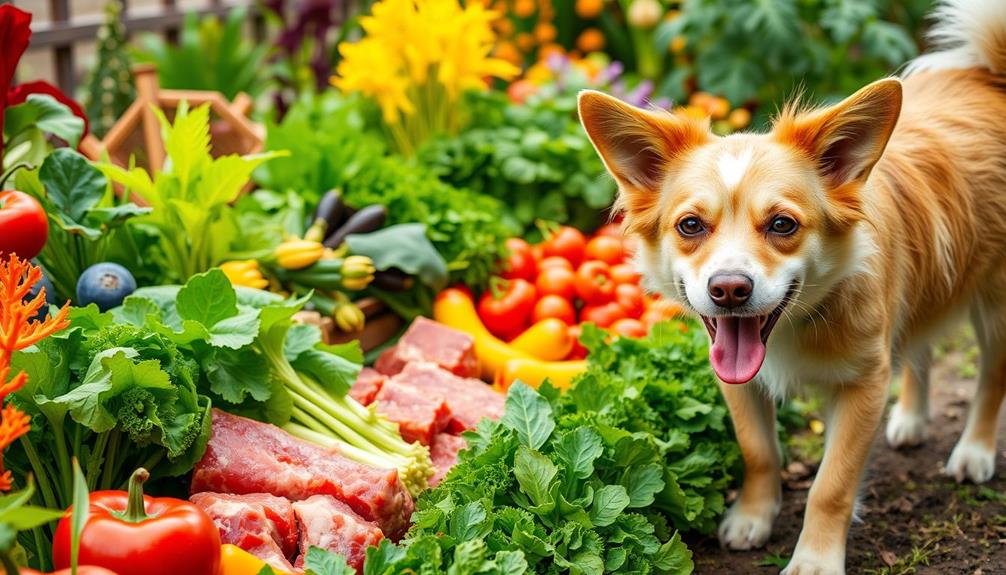
While many dog owners seek out diets that improve their pets' well-being, the health benefits of raw diets stand out considerably. Raw food diets can greatly enhance your dog's health in several ways. First, they promote better digestion by eliminating fillers, leading to improved nutrient absorption. This means your dog gets more out of every meal.
Here's a quick overview of some key benefits:
| Benefit | Description | Impact on Dog |
|---|---|---|
| Healthier Skin | Bioavailable nutrients boost skin health | Reduced irritation |
| Shinier Coat | Active enzymes enhance coat condition | Improved appearance |
| Dental Health | Chewing raw bones reduces plaque | Fewer dental issues |
Additionally, a raw diet can reduce unpleasant odors, thanks to healthier skin and better digestion. You may also notice increased energy levels as your dog utilizes energy more efficiently without excess carbohydrates. Overall, switching to a raw food diet can lead to a noticeable improvement in your dog's health, making them feel and look their best.
Nutritional Considerations
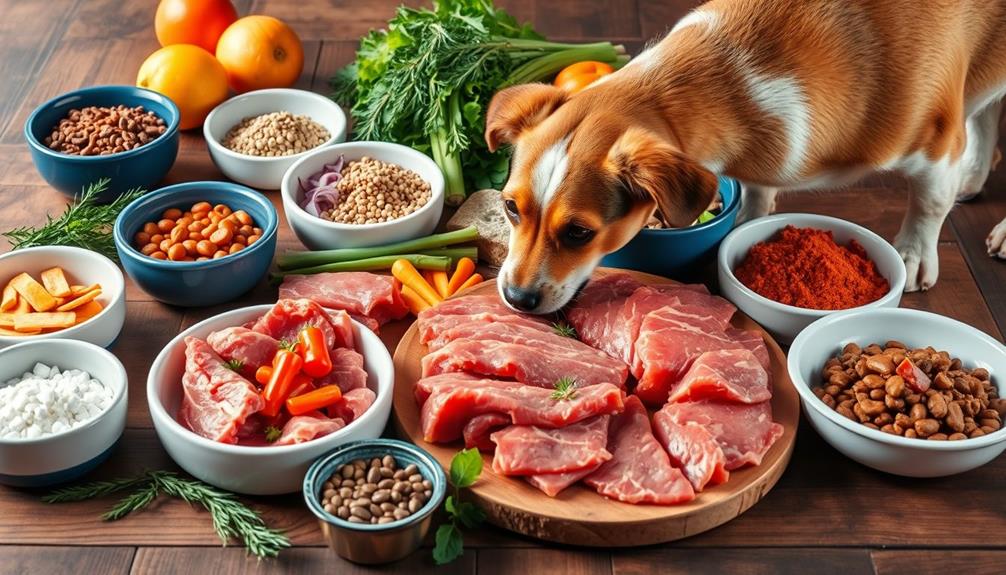
Switching to a raw food diet not only boosts your dog's health but also requires careful attention to nutritional balance. A properly balanced raw diet should include a variety of protein sources, organs, bones, and vegetables to meet all essential nutrient requirements.
Proper animal care practices, including dietary considerations, are fundamental for preventing potential deficiencies and guaranteeing your pet's well-being hamster care tips. Without this balance, nutritional imbalances can arise, leading to serious health issues over time.
One of the key advantages of a raw food diet is the higher levels of bioavailable nutrients, which allow for better absorption and utilization compared to processed foods that often contain fillers and additives.
The lower carbohydrate content in raw diets can help your dog maintain a stable weight and support healthy metabolic function. Additionally, the moisture content in raw foods contributes to natural hydration, benefiting overall health.
To guarantee your dog's diet is complete and balanced, always seek veterinary guidance. They can help you formulate a diet that meets your dog's specific needs, preventing potential deficiencies and guaranteeing they thrive on a raw food diet.
Ultimately, the right nutritional strategy can enhance your dog's energy and well-being.
Safety and Hygiene Practices
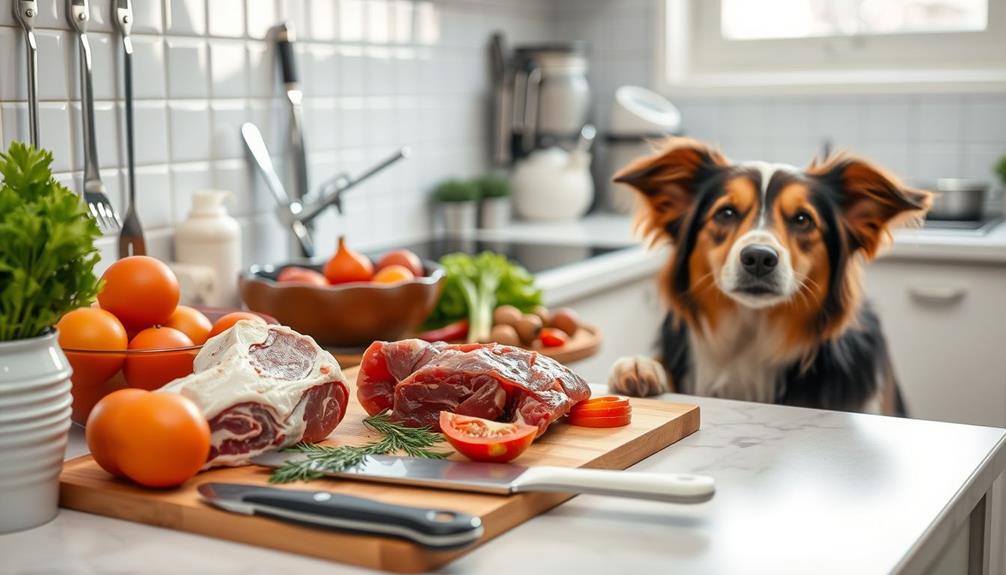
Guaranteeing safety and hygiene practices is vital for anyone feeding their dog a raw food diet. Proper meat handling can greatly minimize the risk of bacterial contamination, which is important for both your health and your dog's. Here are some key practices to follow:
| Practice | Description | Importance |
|---|---|---|
| Handwashing | Always wash your hands thoroughly after handling raw food | Reduces risk of transferring bacteria to surfaces |
| Freezing raw meat | Freeze meat to reduce harmful microorganisms | Not a complete solution; careful preparation needed |
| Separate utensils | Use different cutting boards for raw pet food | Prevents cross-contamination with human food |
| Clean feeding areas | Regularly clean pet dishes and feeding areas | Minimizes lingering bacteria, guaranteeing health safety |
Be especially cautious if you have vulnerable individuals in your home, like young kids or those with weakened immune systems. Feeding a raw diet requires vigilance in maintaining hygiene, as the potential health risks of bacterial contamination can affect both your pets and your family. Prioritizing these safety practices guarantees a healthier environment for your dogs and peace of mind for you.
Transitioning to Raw Food

Adjusting your dog to a raw food diet requires careful preparation and monitoring.
It's important to gradually introduce the new food to avoid digestive upset, while also considering the benefits of essential oils like essential oils for respiratory health that can support your dog's overall wellness during the adjustment.
You'll want to keep an eye on their health improvements and adjust feeding portions as needed.
Preparing for Dietary Change
When you're ready to change your dog's diet to raw food, it's important to approach the shift thoughtfully. Start by gradually introducing the raw dog food diet over 7-10 days. Mixing increasing amounts of raw food with their current food can help minimize gastrointestinal upset, similar to how cold medications can be carefully adjusted to suit individual needs.
During this shift, monitor your dog's response closely for any signs of discomfort or digestive issues, and adjust the mix accordingly.
It's vital to guarantee that the raw diet is nutritionally balanced. Consult a veterinarian to discuss the necessary calcium, vitamins, and minerals that your dog needs.
Additionally, consider portion sizes carefully—typically, you should feed 2-3% of your dog's body weight daily, adjusting based on their activity level and health.
Handling raw ingredients requires attention to hygiene to prevent bacterial contamination. Always wash your hands thoroughly after preparing raw food, and clean any surfaces or utensils used.
Monitoring Health Improvements
As you embrace your dog's new raw food diet, monitoring their health improvements becomes essential for ensuring a successful shift.
You'll want to keep an eye on several key areas to help you gauge how well your furry friend is adapting. Consulting a vet can also provide insights into how this dietary change aligns with your dog's overall health and wellness, especially considering investment regulations regarding their nutritional needs.
- Energy Levels: Many owners report an increase in liveliness shortly after switching to raw food. This boost often stems from more efficient digestion and better nutrient absorption.
- Coat Quality: Pay attention to changes in your dog's coat. A shinier, healthier coat is a common benefit of a raw food diet, thanks to the higher levels of bioavailable nutrients.
- Allergy Symptoms: Document any shifts in allergy symptoms. You might notice a reduction in skin rashes or ear infections as common allergens found in commercial foods are eliminated.
Regular vet check-ups during the shift are essential. They can help identify any potential health problems early, ensuring that your dog's nutritional needs are being met effectively.
Adjusting Feeding Portions
Adjusting your dog's feeding portions is a key step in introducing a raw food diet. It's generally recommended to feed dogs 2-3% of their body weight in raw food daily. However, this may vary based on your dog's activity level and specific nutritional needs.
To guarantee a smooth shift, you should gradually introduce raw food over 7-10 days. Start by mixing a small percentage of raw food with their current diet. Offering healthy dog snacks as treats during this shift can also help your dog adjust more easily.
As you make these adjustments, it's essential to monitor your dog's weight and body condition. This will help you determine if further adjustments are necessary to maintain a healthy weight. A balanced diet is fundamental, so incorporate a variety of protein sources, including organ meats and vegetables, to meet your dog's nutritional requirements.
Additionally, consulting with a veterinarian before making significant changes to feeding portions is important. They can help you guarantee nutritional adequacy and address any specific dietary needs your dog may have.
Common Misconceptions

Many dog owners hold misconceptions about the raw food diet that can lead to confusion and potential health risks for their pets. Understanding these myths is fundamental for making informed decisions about your dog's nutrition.
For instance, just as with body piercings, where proper care is necessary to prevent complications, piercing care and hygiene are equally important when adapting to a raw diet to avoid nutritional imbalances.
- Raw diets are healthy for all dogs: Not every dog is suited for a raw diet. Specific health conditions might make it unsuitable, so it's important to seek a veterinary consultation before making any changes.
- Raw diets don't require planning: Many believe raw diets automatically improve health, but without careful planning, you could face nutritional deficiencies. It's critical to make sure your dog receives all necessary nutrients through balanced raw meals.
- Raw food is free from harmful bacteria: A common misconception is that raw feeding eliminates bacteria, but raw meat can harbor pathogens like Salmonella. Proper handling is fundamental to avoid risks for both pets and humans.
Being aware of these misconceptions helps you navigate the raw food landscape more effectively, making certain your furry friend remains healthy and happy.
Potential Risks Involved

While a raw food diet can offer benefits, it also comes with significant risks that every dog owner should consider. These risks include bacterial contamination, which can expose both your dog and family to pathogens like Salmonella and E. coli. Nutritional imbalances are another concern; if you don't plan your dog's diet carefully, they might miss essential nutrients, leading to deficiencies.
Here's a breakdown of some potential risks:
| Risk | Description | Impact |
|---|---|---|
| Bacterial Contamination | Raw dog food may harbor harmful bacteria. | Affects both pets and owners. |
| Nutritional Imbalances | Improperly balanced diets can lead to deficiencies. | Can affect overall health. |
| Choking Hazards | Whole bones can pose choking risks or cause injuries. | May require veterinary attention. |
Additionally, shifting to raw diets too quickly can result in gastrointestinal upset. Dogs with specific health conditions may face increased risks, as their dietary needs might not align with raw food options. Always monitor your dog's health when making changes to their diet and consult with a veterinarian for tailored advice.
Cost and Time Commitment

Cost and Time Commitment
Switching to a raw food diet for your dog can lead to increased costs and time commitments that you should be prepared for. It's important to take into account the financial implications of maintaining a raw diet, as many financial considerations for elderly care can also apply to pet care.
Here's a breakdown of what to think about:
- Cost: Shifting to a raw diet often requires a higher initial investment compared to commercial foods. You might spend anywhere from $2 to $5 per pound for fresh ingredients or $3 to $6 per pound for commercially prepared raw diets, which can strain your budget.
- Time Commitment: Preparing homemade raw meals can be time-consuming. You'll need to plan meals, source quality ingredients, and guarantee nutrient balance, which takes effort and diligence.
- Ingredient Freshness: To maintain a healthy raw food diet, you'll likely be shopping multiple times a week to keep fresh ingredients on hand. This regular shopping can add to your overall time commitment, making it a challenge for busy pet owners.
Evaluating Your Dog's Needs

When considering a raw food diet for your dog, it's important to evaluate their specific needs. Start by examining your dog's age, breed, and any health conditions that may influence their nutritional needs. For instance, a senior dog might require a different protein balance compared to an active puppy.
Incorporating mindfulness practices can also help you observe their energy levels, coat condition, and digestive health to determine if a nutrient-dense raw diet could be beneficial.
If your dog has any food allergies or sensitivities, it's significant to identify these before altering their diet. Higher energy dogs will often need more protein and balanced nutrients to maintain their active lifestyle.
Regularly monitor your dog's weight and body condition, as a raw diet can support weight management, but portion control is imperative to prevent overfeeding.
Consulting With Veterinarians
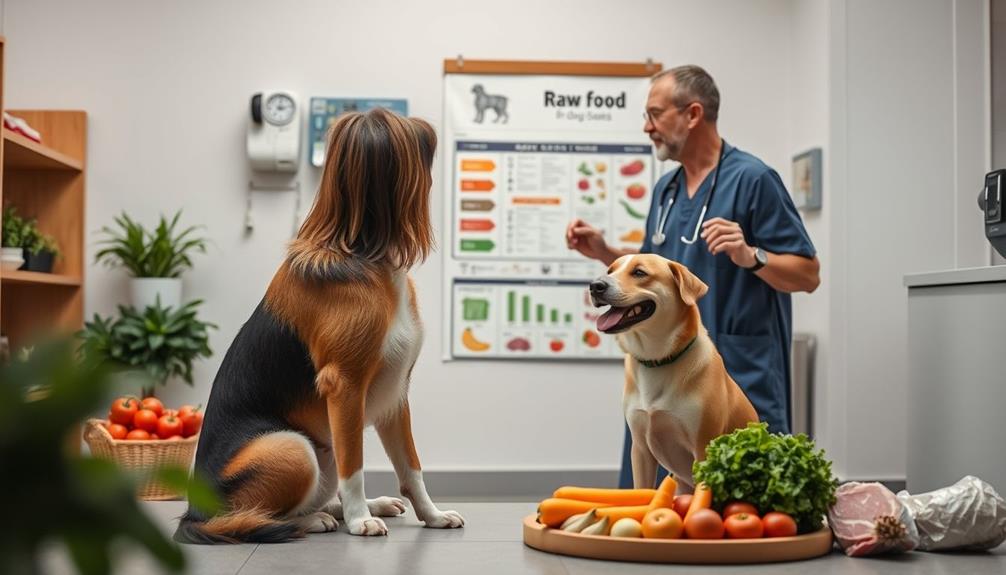
Before making any changes to your dog's diet, it's important to consult with a veterinarian. A raw food diet can be beneficial, but improper meal planning may lead to nutritional imbalances and potential deficiencies.
Your vet can help you navigate this shift safely, much like how understanding the complexities of Borderline Personality Disorder can aid in managing emotional health.
Here are three key reasons to consult your veterinarian:
- Nutritional Balance: Veterinarians can provide guidance on the right components of a raw food diet, including the necessary ratios of meat, bones, and vegetables to guarantee your dog's dietary needs are met.
- Health Monitoring: Regular veterinary check-ups are essential, especially during your dog's shift to a raw food diet. This allows for early detection of any adverse reactions and guarantees your pet's health and well-being.
- Identifying Health Issues: Your vet can help identify any underlying health conditions that may contraindicate a raw diet. This guarantees that your dog's specific health needs are addressed effectively.
Frequently Asked Questions
What Are the Benefits of Feeding Your Dog a Raw Food Diet?
Feeding your dog a raw food diet boosts digestion, enhances skin and coat health, increases energy levels, and helps manage weight. You might notice reduced body odor and improved overall wellness in your furry friend.
What Are the Disadvantages of Raw Food for Dogs?
Raw food diets can expose your dog to bacterial contamination and nutritional imbalances. You might face challenges like preparation time, cost, and potential choking hazards from bones, especially with puppies or dogs with health issues.
Do Vets Recommend a Raw Diet for Dogs?
Most vets aren't exactly throwing a raw meat party for dogs! They often recommend against raw diets due to safety concerns and nutrient balance. Always consult a professional before making any drastic dietary changes for your pup.
Why Do Vets Disagree With Raw Feeding?
Vets disagree with raw feeding mainly due to risks of nutritional deficiencies and bacterial contamination. They warn high protein levels can harm dogs with existing health issues, emphasizing the need for professional consultation before making dietary changes.
Conclusion
In the journey to nourish your dog, raw food can be a game changer, like revealing a treasure chest of health benefits. However, it's essential to weigh both the advantages and potential risks carefully. By understanding your dog's individual needs and consulting with a veterinarian, you can create a balanced approach that fosters energy. As you begin this adventure, remember that every pup deserves a diet that fuels their happiness and well-being.

